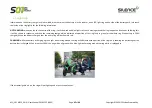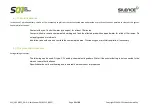
MU_S01 MY22_ENG - User Manual S01 MY22 (V002)
Page
56
of
64
Copyright© SILENCE Urban Ecomobility
c)
Stands
Make sure both the side stand and centre stand are folded away. The side stand has a sensor that prevents the scooter from being driven when it is out, but
the centre stand does not.
d)
Tyres
Always make sure there are no punctures, cracks or tears in the tyres, and that the treads are not worn down. Never drive with worn or defective tyres. Refer
to section “
Scooter specifications (c motor)
” for more information about the correct inflation pressures of your scooter's tyres
.
Driving with the incorrect tyre pressure can damage the tyre and cause an accident, as well as reduce its lifespan.
Rear tyre
It is very important to ensure the correct pressure levels on the rear tyre, since the motor is housed inside this wheel.
It is important to remember that this vehicle has more weight on the rear wheel than conventional vehicles (those without an in-wheel motor), so the rim or
motor can be affected when going over kerbs, potholes or road humps if travelling at the same speed as a conventional vehicle.
WARNING
: If you go over kerbs, potholes or road humps at high speed, you could damage the vehicle’s r
im and/or motor.
e)
Brakes
Brake fluid
The brake fluid tanks are located on the top of the handlebar, one on each side. Check the levels with the scooter resting on both
wheels, not on either stand.
The brake fluid should never fall below the MIN line on the tank. Air can get into the tank if it is empty, which can cause
problems in the scooter’s brake system and compromise safety when driving.
Levels should always be checked and the fluid must be changed every 2 years. If there is not enough, add more DOT4 brake
fluid.









































